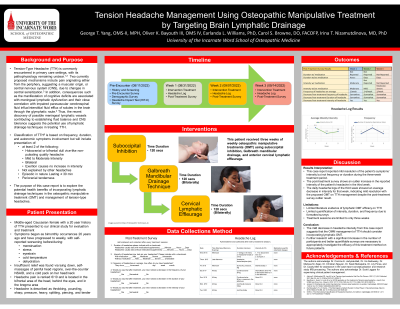Back

OPP/OMT, Biomechanics
Tension Headache Management Using OMT by Targeting Brain Lymphatic Drainage
Friday, March 31, 2023
12:00 PM East Coast USA Time


George T. Yang, OMS-II, MPH (he/him/his)
Medical Student Researcher
University of the Incarnate Word School of Osteopathic Medicine
San Antonio, Texas, United States
Presenting Author(s)
Introduction: Tension-Type Headache (TTH) is commonly encountered in primary care settings. Despite being the most common type of headache, TTH pathophysiology remains unclear. The two currently proposed mechanisms include pain originating either from the periphery, suggesting a muscular origin, or central nervous system (CNS), due to changes in central sensitization. In addition, consequences such as the manifestation of cognitive deficits are associated with meningeal lymphatic dysfunction and their close correlation with impaired paravascular cerebrospinal fluid influx/interstitial fluid efflux of solutes in the brain through the glymphatic route. Thus, the recent discovery of possible meningeal lymphatic vessels contributing to establishing fluid balance and CNS tolerance suggests the potential use of lymphatic drainage techniques in treating TTH.
Case Study: A middle-aged Caucasian female with a history of 20 years of TTH presented to our clinical study for evaluation and treatment. The patient’s symptoms began as bimonthly occurrences 20 years ago and have progressed to weekly, worsening before/during menstruation, stress, eyestrain, cold temperature, and dehydration. Insufficient relief is found via lying down, self-massages of painful head regions, over-the-counter NSAID, and a cold pack on her head/neck. Headache pain is ranked 6/10, located bilaterally in the frontal area of the head, behind the eyes, and in the bregma area, and is described as throbbing, pounding, sharp, pressure, heavy, splitting, piercing, and tender. A pre-encounter survey with physician evaluation ruled out migraines and other related headaches.
This patient received three weeks of weekly osteopathic manipulative treatments (OMT) using suboccipital inhibition, Galbreath mandibular drainage, and anterior cervical lymphatic effleurage. Post-treatment surveys and headache logs collected after post-treatments reported mild resolution of her symptoms’ intensity but not frequency during her three-week treatment period.
Discussion: This case report explores the potential health benefits of OMT regarding managing tension headaches through the body’s ability to self-regulate by assisting lymphatic drainage of the CNS. Most literature on OMT regarding TTH management has focused mainly on musculoskeletal techniques, and few have explored incorporating lymphatic drainage. This case report suggests a new possibility in research and clinical approach regarding TTH treatment via incorporating a lymphatic drainage approach that focuses on fluid balance in relation to tension headaches. Though our utilization of anterior cervical lymphatic effleurage manipulates Sibson's fascia bilaterally, future studies may benefit from thoracic inlet release being performed first in order to potentially facilitate further lymphatic drainage.
Case Study: A middle-aged Caucasian female with a history of 20 years of TTH presented to our clinical study for evaluation and treatment. The patient’s symptoms began as bimonthly occurrences 20 years ago and have progressed to weekly, worsening before/during menstruation, stress, eyestrain, cold temperature, and dehydration. Insufficient relief is found via lying down, self-massages of painful head regions, over-the-counter NSAID, and a cold pack on her head/neck. Headache pain is ranked 6/10, located bilaterally in the frontal area of the head, behind the eyes, and in the bregma area, and is described as throbbing, pounding, sharp, pressure, heavy, splitting, piercing, and tender. A pre-encounter survey with physician evaluation ruled out migraines and other related headaches.
This patient received three weeks of weekly osteopathic manipulative treatments (OMT) using suboccipital inhibition, Galbreath mandibular drainage, and anterior cervical lymphatic effleurage. Post-treatment surveys and headache logs collected after post-treatments reported mild resolution of her symptoms’ intensity but not frequency during her three-week treatment period.
Discussion: This case report explores the potential health benefits of OMT regarding managing tension headaches through the body’s ability to self-regulate by assisting lymphatic drainage of the CNS. Most literature on OMT regarding TTH management has focused mainly on musculoskeletal techniques, and few have explored incorporating lymphatic drainage. This case report suggests a new possibility in research and clinical approach regarding TTH treatment via incorporating a lymphatic drainage approach that focuses on fluid balance in relation to tension headaches. Though our utilization of anterior cervical lymphatic effleurage manipulates Sibson's fascia bilaterally, future studies may benefit from thoracic inlet release being performed first in order to potentially facilitate further lymphatic drainage.
